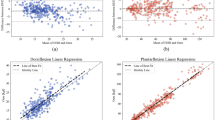Abstract
This study was designed to investigate the intratester and intertester reliability of isokinetic ankle inversion and eversion-strength measurement in neutral foot position in healthy adults using the Biodex dynamometer. Twenty-five men and women performed five maximal concentric contractions at 60 and 180°/s angular velocities. Two physicians tested each subject. The first physician applied the test four times, and the second physician three times. Reliability of peak torque was assessed by calculating the intraclass correlation coefficient (ICC). At both angular velocities, inversion strength was greater than eversion, and when the angular velocity was increased, inversion and eversion strength were decreased, as tested by both physicians. The first measurements of inversion and eversion strength of the first physician were significantly lower than the other measurements (p<0.01). The intratester ICCs for ankle inversion in healthy young adults were highly reliable (ICC 0.92–0.96), and for the eversion values ranged from 0.87 to 0.94. Intertester ICCs for ankle inversion and eversion peak torque values demonstrated a value of 0.95. Isokinetic tests of ankle inversion and eversion strength at 60 and 180°/s angular velocities in neutral foot position for healthy adults are highly reliable with the Biodex dynamometer.

Similar content being viewed by others
References
Kannus P (1994) Isokinetic evaluation of muscular performance: implications for muscle testing and rehabilitation. Int J Sports Med 15:S11–S18
Trappe SW, Trappe TA, Lee GA, Costill DL (2001) Calf muscle strength in humans. Int J Sports Med 22:186–191
Frontera WR, Hughes VA, Dallal GE, Evans WJ (1993) Reliability of isokinetic muscle strength testing in 45- to 78-year-old men and women. Arch Phys Med Rehabil 74:1181–1185
Harries UJ, Bassey EJ (1990) Torque–velocity relationship for the knee extensor in women in their 3rd and 7th decades. Eur J Appl Physiol 60:187–90
Holmback AM, Porter MM, Downham D, Lexell J (1999) Reliability of isokinetic ankle dorsiflexor strength measurement in healthy young men and women. Scand J Rehab Med 31:229–239
Karatas GK, Gogus F, Meray J (2002) Reliability of isokinetic trunk muscle strength measurement. Am J Phys Med Rehabil 81:79–85
Perrin DH (1993) Isokinetic exercise and assessment. Human Kinetics, Champaign
Kaminski T, Dover G (2001) Reliability of inversion and eversion peak-and average-torque measurements from the Biodex system 3 dynamometer. J Sport Rehabil 10:205–220
Leslie M, Zachazewski J, Browne P (1990) Reliability of isokinetic torque value for ankle invertors and evertors. J Orthop Sports Phys Ther 11:612–616
Munn J, Beard DJ, Refshauge KM, Lee RY (2003) Eccentric muscle strength in functional ankle instability. Med Sci Sports Exerc 35:245–250
Kilfoil MR, Pierre DMM (1993) Reliability of Cybex II isokinetic evaluations of torque in post-poliomyelitis syndrome. Arch Phys Med Rehabil 74:730–735
Andersen H (1996) Reliability of isokinetic measurement of ankle dorsal and plantar flexors in normal subjects and in patients with peripheral neuropathy. Arch Phys Med Rehabil 77:265–268
Hart D, Stobbe T, Till C, Plummer R (1984) Effect of trunk stabilization on quadriceps femoris muscle torque. Phys Ther 64:1375–1380
Johnson L (1981) Cybex II hip and trunk stabilization during quadriceps/hamstring evaluation. J Orthop Sports Phys Ther 2:191–193
Keating JL, Matyas TA (1996) The influence of subject and testing design on dynamometric measurement of extremity muscles. Phys Ther 76:866–889
Morris-Chata R, Buchner DM, de Lateur BJ, Cress ME, Wagner EH (1994) Isokinetic testing of ankle strength in older adults: inter-rater reliability and stability of strength over six months. Arch Phys Med Rehabil 75:1213–1216
Oberg B, Bergman T, Trop G (1987) Testing of isokinetic muscle strength in the ankle. Med Sci Sports Exerc 51:750–754
Peacock B, Westers T, Walsh S, Nicholson K (1981) Feedback and maximum voluntary contraction. Ergonomics 24:223–228
Author information
Authors and Affiliations
Corresponding author
Rights and permissions
About this article
Cite this article
Aydoğ, E., Aydoğ, S.T., Çakci, A. et al. Reliability of isokinetic ankle inversion- and eversion-strength measurement in neutral foot position, using the Biodex dynamometer. Knee Surg Sports Traumatol Arthrosc 12, 478–481 (2004). https://doi.org/10.1007/s00167-004-0530-8
Received:
Accepted:
Published:
Issue Date:
DOI: https://doi.org/10.1007/s00167-004-0530-8




